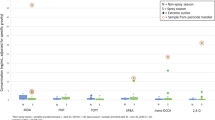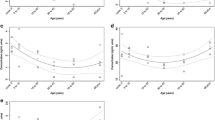Abstract
Purpose
Cypermethrin is a pyrethroid pesticide widely used in agriculture. Exposure can be assessed through biomonitoring. However, interpretation of results requires a proper knowledge of the toxicokinetics of the exposure biomarkers of interest. This study aimed at characterizing typical urinary time courses of biomarkers of exposure to cypermethrin in farm workers in Quebec following an exposure episode, distribution of values and variability, and predictors of elevated excretion levels.
Methods
Workers provided total voids before seasonal spraying and during three consecutive days following an exposure period. Personal factors, professional tasks, and exposure conditions were documented by questionnaire. The urinary metabolites cis- and trans-3-(2,2-dichlorovinyl)-2,2-dimethylcyclopropane-1-carboxylic acids (DCCA) and 3-phenoxybenzoic acid (3-PBA) were quantified.
Results
Time courses showed significant variations of metabolite levels through time, although a clear profile typical of an acute exposure episode was not observed for several workers. However, maximum urinary levels in most exposed workers were generally reached 18–32 h following the onset of an exposure episode. Group comparison showed that applicators had higher excretions than workers performing inspection, harvest, or weeding.
Conclusions
Time-dependent variations in excretions indicate the importance of serial urinary collections for a proper interpretation of a worker exposure pattern. In the context of group comparison, the alternative based on observed time courses and peak levels in most exposed workers would be the collection of urine samples prior to an exposure episode, at the end-of-shift after exposure onset and following morning void. When spot samples can only be collected for population exposure assessment, Monte Carlo simulations showed that iterative random selection of single urinary values from individual time courses observed in this study to predict distribution of values in the group of workers converged to similar central tendencies.


Similar content being viewed by others
References
Aktar W, Sengupta D, Chowdhury A (2009) Impact of pesticides use in agriculture: their benefits and hazards. Interdiscip Toxicol 2(1):1–12
Arcury TA, Quandt SA, Barr DB, Hoppin JA, McCauley L, Grzywacz JF, Robson MG (2006) Farmworker exposure to pesticides: methodologic issues for the collection of comparable data. Environ Health Perspect 114(6):923–928
Baldi I, Lebailly P, Jean S, Rougetet L, Dulaurent S, Marquet P (2006) Pesticide contamination of workers in vineyards in France. J Expo Sci Environ Epidemiol 16:115–124
Barr DB, Leng G, Berger-Preiss E, Hoppe HW, Weerasekera G, Gries W, Gerling S, Perez J, Smith K, Needham LL, Angerer J (2007) Cross validation of multiple methods for measuring pyrethroid and pyrethrum insecticide metabolites in human urine. Anal Bioanal Chem 389:811–818
Barr DB, Olsson AO, Wong L-Y, Udunka S, Baker SE, Whitehead RDJ, Magsumbol MS, Williams BL, Needham LL (2010) Urinary concentrations of metabolites of pyrethroid insecticides in the general US population: National Health and Nutrition Examination Survey 1999–2002. Environ Health Perspect 118:742–748
Berthet A, Heredia-Ortiz R, Vernez D, Danuser B, Bouchard M (2012) A detailed urinary excretion time course study of captan and folpet biomarkers in workers for the estimation of dose, main route-of-entry and most appropriate sampling and analysis strategies. Ann Occup Hyg 56(7):815–828
Boeniger MF, Lowry LK, Rosenberg J (1993) Interpretation of urine results used to assess chemical exposure with emphasis on creatinine adjustments: a review. Am Ind Hyg Assoc J 54(10):615–627
Bradberry SM, Cage SA, Proudfoot AT, Vale JA (2005) Poisoning due to pyrethroids. Toxicol Rev 24(2):93–106
Choi J, Rose RL, Hodgson E (2002) In vitro human metabolism of permethrin: the role of human alcohol and aldehyde dehydrogenases. Pest Biochem Physiol 73:117–128
Couture C, Fortin MC, Carrier G, Dumas P, Tremblay C, Bouchard M (2009) Assessment of exposure to pyrethroids and pyrethrins in a rural population of the Montéregie area, Quebec, Canada. J Occup Environ Hyg 6(6):341–352
Dalvie MA, Africa A, Solomons A, London L, Brouwer D, Kromhout H (2009) Pesticide exposure and blood endosulfan levels after first season spray amongst farm workers in the Western Cape, South Africa. J Environ Sci Health (B) Pestic Food Contam Agric Wastes 44(3):271–277
Fenske RA (1988) Comparative assessment of protective clothing performance by measurement of dermal exposure during pesticide applications. Appl Ind Hyg 3(1):207–213
Fenske RA (1990) Nonuniform dermal deposition patterns during occupational exposure to pesticides. Arch Environ Contam Toxicol 19:332–337
Ferland S, Côté J, Ratelle M, Thuot T, Bouchard M (2015) Detailed time profiles of biomarkers of exposure in workers exposed to permethrin in a corn production farm in Quebec, Canada. Ann Occup Hyg. doi:10.1093/annhyg/mev059
Fortin MC, Bouchard M, Carrier G, Dumas P (2008) Biological monitoring of exposure to pyrethrins and pyrethroids in a metropolitan population of the province of Quebec, Canada. Environ Res 107:343–350
Fromme H, Bolte G, Koch HM, Angerer J, Boehmer F, Drexler H, Mayer R, Liebl B (2007) Occurrence and daily variation of phthalate metabolites in the urine of an adult population. Int J Hyg Environ Health 210:21–33
Gorse I, Balg C (2013) Bilan des ventes de pesticides au Québec pour l’année 2010, Québec. Ministère du Développement durable, de l’Environnement, de la Faune et des Parcs, Gouvernement du Québec, Québec, Canada, 85 p
Gueguen Y, Mouzat K, Ferrari L, Tissandie E, Lobaccaro JMA, Batt A-M, Paquet F, Voisin P, Aigueperse J, Gourmelon P, Souidi M (2006) Cytochromes P450: xenobiotic metabolism, regulation and clinical importance. Ann Biol Clin 64(6):535–548
Hadnagy W, Leng G, Sugiri D, Ranft U, Idel H (2003) Pyrethroids used indoors–immune status of humans exposed to pyrethroids following a pest control operation–a one year follow-up study. Int J Hyg Environ Health 206:93–102
Hardt J, Angerer J (2003) Biological monitoring of workers after the application of insecticidal pyrethroids. Int Arch Occup Environ Health 76:492–498
Havenith G (1999) Heat balance when wearing protective clothing. Ann Occup Hyg 43(5):289–296
Health Canada (2011) Food Guide. Government of Canada, Canada. http://www.hc-scgcca/fn-an/alt_formats/hpfb-dgpsa/pdf/food-guide-aliment/print_eatwell_bienmang-engpdf. Accessed 14 July 2014
Health Canada (2012) Maximum residue limit (MRL)-MRL database. Government of Canada, Canada. http://www.hc-scgcca/cps-spc/pest/part/protect-proteger/food-nourriture/mrl-lmr-engphp. Accessed 14 July 2014
Health Canada (2013) Second report on human biomonitoring of environmental chemicals in Canada: Canadian Health Measures Survey (CHMS)—Cycle 2 (2009–2011). Government of Canada, 446 p
Housset P, Dickmann R (2009) A promise fulfilled—pyrethroid development and the benefits for agriculture and human health. In: Proceedings of the pyrethroid scientific forum 2009, vol 62, issue no 2, pp 135–143
Kuhn K-H, Wieseler B, Leng G, Idel H (1999) Toxicokinetics of pyrethroid in humans: consequences for biological monitoring. Bull Environ Contam Toxicol 62:101–108
Lafortune M, Panisset JC (1988) Mesure de risque d’exposition aux pesticides pour les producteurs agricoles du Québec. Travail et Santé 4(2):S9–S14
Le Grand R, Dulaurent S, Gaulier JM, Saint-Marcoux F, Moesch C, Lachâtre G (2012) Simultaneous determination of five synthetic pyrethroids metabolites in urine by liquid chromatography-tandem mass spectrometry: application to 39 persons without know exposure to pyrethroids. Toxicol Lett 210(2):248–253
Leng G, Kühn KH, Idel H (1996) Biological monitoring of pyrethroid metabolites in urine of pest control operators. Toxicol Lett 88(18):215
Leng G, Gries W, Selim S (2006) Biomarker of pyrethrum exposure. Toxicol Lett 162:195–201
MAPAQ-Ministère de l’agriculture, pêcherie et alimentation du Québec (2010) L’emploi bioalimentaire. Government of Quebec, Quebec, Canada. http://www.mapaq.gouv.qc.ca/fr/md/statistiques/Pages/emploi.aspx. Accessed 23 May 2013
MDDEP (2012) Bilan des ventes de pesticides au Québec pour l’année 2009, Québec, Ministère du Développement durable, de l’Environnement et des Parcs. Government of Quebec, Quebec, Canada, 85 p. ISBN 978-2-550-64375-3
Meeker JD, Barr DB, Ryan L, Herrick RF, Bennett DH, Bravo R, Hauser R (2005) Temporal variability of urinary levels of nonpersistent insecticides in adult men. J Expo Sci Environ Epidemiol 15:271–281
NHANES (2003) Third national report on human exposure to environmental chemicals. National Health and Nutrition Examination Survey National Center for Health Statistics, Hyattsville, MD
NHANES (2009) Fourth national report on human exposure to environmental chemicals National Health and Nutrition Examination Survey, Atlanta (GA), 529 p
Panuwet P, Prapamontol T, Chantara S, Thavornyuuthikarm P, Montesano MA, Whitehead RDJ, Barr DB (2008) Concentrations of urinary pesticide metabolites in small-scale farmers in Chiang Mai province, Thailand. Sci Total Environ 407:655–668
Ratelle M, Côté J, Bouchard M (2015) Systematic comparison of toxicokinetic parameters of cypermethrin and permethrin biomarkers of exposure in orally exposed volunteers. J Appl Toxicol. doi:10.1002/jat.3124
Soderlund DM, Clark JM, Sheets LP, Mullin LS, Piccirillo VJ, Sargent D, Stevens JT, Weiner ML (2002) Mechanisms of pyrethroid neurotoxicity: implications for cumulative risk assessment. Toxicology 171:3–59
Thiphom S, Prapamontol T, Chantara S, Mangklabruks A, Suphavilai C, Ahn KC, Gee SJ, Hammock BD (2014) Determination of the pyrethroid insecticide metabolite 3-PBA in plasma and urine samples from farmer and consumer groups in northern Thailand. J Environ Sci Health (B) 49:15–22
Thomas R, Bigelow PI, Keefe TJ, Yang RSH (1996) Variability in biological exposure indices using physiologically based pharmacokinetic modeling and Monte Carlo simulation. Am Ind Hyg Assoc J 57:23–32
Vermeulen R, Stewart P, Kromhout H (2002) Dermal exposure assessment in occupational epidemiologic research. Scand J Work Environ Health 28:371–385
Viau C, Lafontaine M, Payan JP (2004) Creatinine normalization in biological monitoring revisited: the case of 1-hydroxypyrene. Int J Occup Med Environ Health 77:177–185
Wang D, Kamijima M, Imai R, Suzuki T, Kameda Y, Asai K, Okamura A, Naito H, Ueyama J, Saito I, Nakajima T, Goto M, Shibata E, Kondo T, Takagi K, Wakusawa S (2007) Biological monitoring of pyrethroid exposure of pest control workers in Japan. J Occup Health 49(6):509–514
WHO (1996) Biological monitoring of chemical exposure in the workplace, vol 1. World Health Organization, Geneva
Whyatt RM, Garfinkel R, Hoepner LA, Andrews H, Holmes D, Williams MK, Reyes A, Diaz D, Perera FP, Camann DE, Barr DB (2009) A Biomarker validation study of prenatal chlorpyrifos exposure within an inner-city cohort during pregnancy. Environ Health Perspect 117(4):559–567
Woollen BH, Marsh JR, Laird WJD, Lesser JE (1992) The metabolism of cypermethrin in man: differences in urinary metabolite profiles following oral and dermal administration. Xenobiotica 22:983–991
Zhao M, Chen F, Wang C, Zhang Q, Gan J, Liu W (2010) Integrative assessment of enantioselectivity in endocrine disruption and immunotoxicity of synthetic pyrethroids. Environ Pollut 158:1968–1973
Zuur A, Leno EN, Walker N, Saveliev AA, Smith GM (2009) Mixed effects models and extensions in ecology with R. In: Gail M, Samel JM, Tsiatis A, Wong W (eds) Statistics for biology and health. Springer, New York, NY, p 574
Acknowledgments
The study was funded by the Institut de recherche Robert-Sauvé en santé et sécurité du travail du Québec (IRSST). Mylène Ratelle received a Ph.D. scholarship from the Faculty of Medicine of the University of Montreal and the University of Montreal’s Public Health Research Institute (IRSPUM).
Author information
Authors and Affiliations
Corresponding author
Ethics declarations
Conflict of interest
The authors declare that there are no conflicts of interest.
Rights and permissions
About this article
Cite this article
Ratelle, M., Côté, J. & Bouchard, M. Time courses and variability of pyrethroid biomarkers of exposure in a group of agricultural workers in Quebec, Canada. Int Arch Occup Environ Health 89, 767–783 (2016). https://doi.org/10.1007/s00420-016-1114-x
Received:
Accepted:
Published:
Issue Date:
DOI: https://doi.org/10.1007/s00420-016-1114-x




